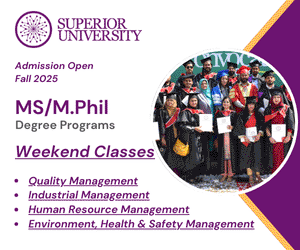Some programs will have a minimum Grade Point Average (GPA) requisite for admission. As the Pakistani grading system is quite different than the U.S. grading system, it's best not to try to convert your grades from Pakistan, but instead to include your academic records and if possible, an explanation from your secondary school or university about the grading system. Most institutions are familiar with the Pakistan system and understand that there is no direct equivalency.
Professional Experience
Certain graduate level programs, mostly in Business. Management or other professional fields like to see proof of professional work experience in a field related to the field of study. Check the program's website to see about these requirements.
Student Visa
The United States welcomes foreign citizens who wanted to study. Most of those who wish to study in the United States will seek an F-1 student visa, but there are other visa kinds that are occasionally used. A short explanation of the two types of student visas is given below.
F-1 Type Student Visa
This visa is the most general for those who wish to engage in academic studies in the United States. It is for those who want to study at an accredited U.S. college or university. If you are going to the United States to study and your course of study is more than 18 hours a week, you will need an F-1 or M-1 visa.
Note: You do not need a student visa to attend recreational schools such as tennis or golf camps. If you are traveling to the United States for tourism, but will incidentally attend school less than 18 hours per week (less than 12 for universities), a B-1/B-2 visa may be used in lieu of an F visa.
M-1 Type Student Visa
This visa is for those who will be engaged in non-academic or vocational study or training at a U.S. institution. If you are traveling to the United States for tourism, but will incidentally attend school less than 18 hours per week, a B-1/B-2 visa may be used in lieu of M visa.
More information about these visas and opportunities for studying in the United States can be found at https://www.educationusa.state.gov/usvisa.htm
Dependents of Student Visa holder
Spouses and/or unmarried children under the age of 21 who wish to accompany or join the principal visa holder in the United States for the duration of his/her stay require derivative F or M visas. Spouses and/or children who do not intend to reside in the United States with the principal visa holder, but visit for vacations only, may be eligible to apply for visitor (B-2) visas. Spouses and dependents may not work in the United States on a derivative F or M visa. If seeking employment, the appropriate work visa will be required.
Optional Practical Training (OPT)
Per 9 FAM 41.61 note 12.4-2, students are eligible for up to 12 months of optional practical training following completion of all course requirements for graduation (not including thesis or equivalent), or after completion of all requirements, OPT is separate from a student's academic work, and time for OPT will not normally be reflected during the student's academic program or in the completed study date. Students applying for a F-visa to do choose may present an I-20 with an original end of study date that may have passed. However, these I-20s must be annotated by the designated school official to reflect approval of an OPT program that extends beyond the end of the regular period of study. In addition, the student must have proof of DHS receipt of application or approval for a practical training program, either in the form of an approved Employment Authorization Card or an I-797 indicating that s/he has applied for DHS approval for an OPT program.
Validity of Student Visas after a Break in Studies
There are two circumstances in which a student's visa is automatically invalidated after a break in studies longer than five months.
Students who are not studying but remain in the United States: An individual admitted in F-1 or M-1 status to study in the United States who is transferring between schools or programs is no longer regarded to be in student status if classes are not resumed within 5 months of the date of transferring out of the previous school or within 5 months of the date of the program completion, whichever is applicable. In order for such a student to restore lawful status, she/he must apply for restoration of student status with USCIS, which has the option to approve or deny reinstatement of student status. A student may pursue studies while reinstatement is pending.
Students who depart the United States while in valid student status: When a student has been out of the United States for more than 5 months, the student's F-1 or M-1 visa is considered to be invalid based on U.S. immigration law. After an absence of more than 5 months, a foreign national is no longer admissible at a U.S. port-of-entry as a continuing student. Such a student's visa is subject to cancellation and should not be used. In such cases, a student who wishes to resume study in the United States must obtain a new student visa.
Students who have the approval of their schools to take an extended break from study must have their SEVIS record terminated for Authorized Withdrawal. When the student is ready to resume study, the school will issue the student a new initial Form I-20 with a new SEVIS number. These students must also pay the SEVIS fee.
Some students depart the United States for extended periods of time for activities related to their course of study, such as field research. Schools are expected to maintain those students in an active SEVIS status. Since these students continue to maintain their student status while overseas, their F-1 visas are not considered invalid after an absence of more than 5 months.
..........











